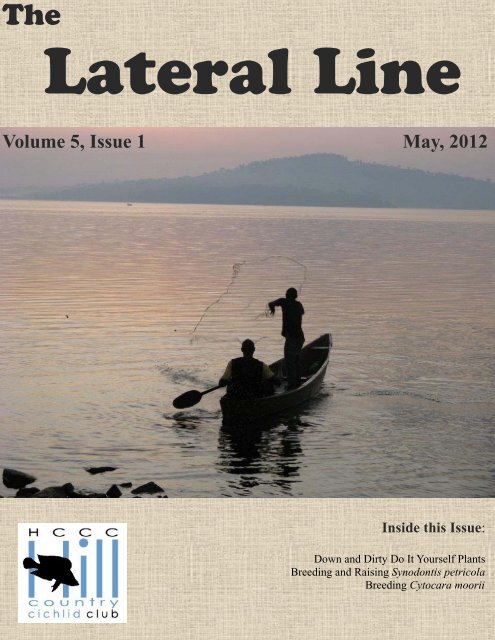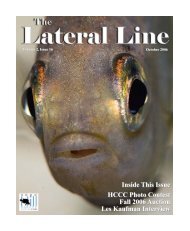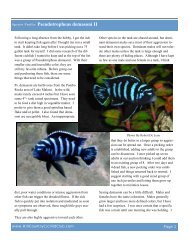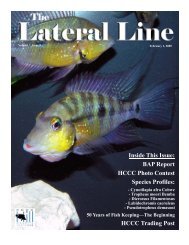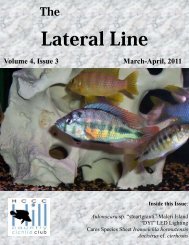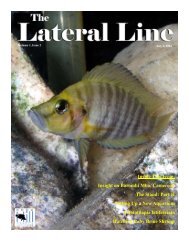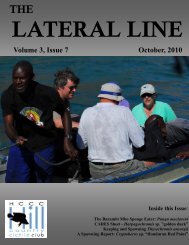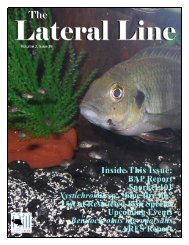May - Hill Country Cichlid Club
May - Hill Country Cichlid Club
May - Hill Country Cichlid Club
- No tags were found...
Create successful ePaper yourself
Turn your PDF publications into a flip-book with our unique Google optimized e-Paper software.
TheLateral LineVolume 5, Issue 1 <strong>May</strong>, 2012Inside this Issue:Down and Dirty Do It Yourself PlantsBreeding and Raising Synodontis petricolaBreeding Cytocara moorii
2Down and Dirty Do it Yourself Plants- Walter Wooton Jr.Breeding Synodontis perticola- Mike KaakiCytocara moorii: A breeding report- Greg SteevesCover: A beautiful shot of two Ugandan fisherman casting into Lake Victoria.Photo by Lawrence KentThe HCCC is a proud member ofthe Federation of TexasAquarium Societies.The HCCC is a proud member ofthe Federationof American AquariumSocieties.What? Finally a new issue of the LateralLine? Indeed. This is the <strong>May</strong> issue andwas started last December. Unfortunately,contributions have been slow coming to meand it seems that whenever I had planned tosit down and crank an issue out, somethingalways came up. This got me thinking, I’vebeen editor for three plus years now. I hadtaken it over from Robert who, quite frankly,I think felt the same way about things that Ido now. I love the Lateral Line. I’ve alwaysthought of it as showcasing our memberstalents and abilities when it comes tofish keeping. I especially enjoyed helpingnew contributors see their writing effortstransformed into great articles. I would liketo assist with putting the Lateral Line togetherin a timely manner, but it is time forme to pass the torch. If you are interested inbecoming the Lateral Line editor, please letme know. You should not be intimidated atall. The software is easy to use and as I said,I intend to stick around and help out whereneeded.Last month we had a great auction! Therewere lots of new faces and lots of cool fish,plants and equipment to bid on. I got somegreat fish for the pond and didn’t bid againstLee Ann on anything (that I know of). Ithink that’s a first. Charles and Rare Davedid the entire auction. Diane is now handlingfinances for the HCCC as well. Theauction went very smooth and checks weresent out in a timely manner. All in all, a fantasticevent. We’re still working on settingup a summer auction and the Last Sunday ofJuly is the date mentioned. Stay tuned closeto the website for further details.If we can get enough people interested, theclub will be hosting an outing at AquarenaSprings in San Marcos the last weekend ofJune. This will include a glass bottom boatride and who knows what else. The lasttime we did this, we all had a great time.If you guys get a chance, there’s a good roadtrip opportunity coming up June 17th. TheHouston Aquarium Society is holding theirsummer auction. Any HAS auction is alwaysa blast. Don’t forget about FOTAS inIrving September 14-16. Lets have a goodHCCC contingent attend!
4Down and Dirty Do It Yourself Plants- Walter Wooton Jr.There are times that we would like to addsome green to our tanks for various reasonsfrom ascetics to necessity. We don't do liveplants because of "blackthumbs," incompatible water parameters orthe fish we keep will destroy them.The option of putting in fake plants is a optionand if you are just adding a few accentspicking up few commercially made ones isn'ta big deal but if the need or desire is fora heavily planted look it can get to be quiteexpensive. I recently had a need for doing a"heavily planted tank" and I was able to do itfor around $40.00. The list of tools and materialsis short and simple as is the process todo your own personnel creations.Tools: A pair of tin snips or wire cutters, apair of scissors, hot glue gun with glue sticksSupplies: Needle point cloth, silk plantsfrom a craft store
5Preparation and assembly is simple too.Wash all your plants to make sure there isnothing on them that can foul your tank thencut the individual stems from the buncheswhile your glue gun heats up.Next step is to take the individual stems andpoke them randomly through the needlepoint cloth so they just come through. Do afew at a time securing each one both top andbottom to the cloth with the hot glue. If youtry to do to many at once they will fall out sojust work it slowly till you get the desiredeffect you are looking for then cut away theextra cloththe way to the bottom. The weight of thesand will do a good job of holding your designin place. These can be made as big or assmall as you want from a "forest" to a singlestem (2" X 2" seems to work for smallerpieces). A piece of flagstone can be usedinstead of the cloth if you desire just glue theindividual stems on and hold eachone until it is cool. I like the cloth bettersince after it is placed in the tankyou want to change it up (or move it to anothertank) it is a simple mater of pulling itout and cutting the cloth to get the new design.It can also be removed and more addedto it if you would like to make itdenser. Another option to secure the stemsto cloth of stone would be an aquarium safesilicone, but it will take longer to set up andrequires 24 (minimum) to 48 hours(preferred) to cure enough to place in thetank. A little imagination and a little effortyou can tank a tank form this:to this:Placing the pieces in the tank is easy. Insertthe rear of your mesh forward of where youwant it to be and work it under the sand bysliding it back and forth till it is buried all
6Breeding and Raising Synodontis petricola- Mike KaakiSynodontis petricola is a small catfish fromLake Tanganyika. They look very much likeS. multipunctatus except they are smaller.They prefer hard water and warm temperatureat 79 degrees. They grow to about fiveinches long. I found it easy to tell the differencebetween adult males and females.Males are thinner and smaller while femalesare larger.I started with three pairs that I purchasedfrom a fellow hobbyist in our club. I did alittle research on the web and found that itwas difficult to get accurate information.Synodontis petricola scatter their eggs, andthey are not host layers like S. multipunctatus.Immediately, I set up my 40 gallonbreeder tank with a clay pot and a bowl fullof black marbles. It didn't take too long beforethe first pair started the breeding process.I had eggs everywhere between the marbles,and I couldn't easily remove them. Ihad five fry that made it to a 2.5 gallon tank.I started feeding them small amounts of firstbites after a few days.They started spawning again a few weekslater. My goal was to find away to easilycollect the eggs when I find them. I had anold fishnet with large holes, so I decided tocover the bowl with the fishnet and place themarbles in it. It worked for me. I was able tocollect the eggs and place them in a hatchingjar. I collected many fry from the secondspawn. Their growth is slow but steady. After35 days, they are about half an inch long.At this point, I feel I am still learning aboutthem. I have raised two broods and havemade many mistakes with each one of them;however, I feel that I have also learned frommy mistakes. My next goal is to raise a largebrood.
8Breeding Cyrtocara moorii, The Blue Dolphin- Greg SteevesA stunning male Cyrtocara moorii from Lake Malawi, in the author’s aquarium.It has been a while since I’ve deviated out ofmy comfort zone and wrote about anythingother than haplochromine cichlids. AlthoughI consider the former group of cichlidsmy favorite, many of the species fromLake Malawi slide in a close second. I, asmost cichlid hobbyists, would someday liketo go to this great African Rift Lake and seethose colorful fishes first handThe nomenclatural history of Cyrtocaramoorii is not nearly as complex as the namegame with other Malawian fishes. It is, infact, fairly simple and the players are familiarnames within the haplochromine realm.The British scientist George AlbertBoulenger initially described Cyrtocaramoorii, a monotypic genus, at the turn of the20 th century (1902). In 1935, EthelwynnTrewawas, the first in a line of remarkableBritish female ichthyologists reclassified thespecies as Haplochromis moorii. For us oldtimers,we can recall that in the not so longago past, everything that came out of LakeMalawi that was not an mbuna, was usuallycalled “Haplochromis”. Trewawas cited aRegan (another one of those British fish scientists)hallmark for inclusion into the“Haplochromis” group considering “a continuousmargin in the dorsal fin” as reason(Konings, 2007). Eccles and Trewawasagain examined the fish in 1989 reinstatedBoulenger’s original genus name“Cyrtocara” and that is where we stand today,one of the few monotypic cichlid genus’of Lake Malawi. .
9A portion of the breeding group of Cyrtocara moorii.
10A holding female C. moorii. The buccal cavity extension can be subtle.The genus name stems from Greek roots.“Cyrtocara” translates to “curved-face”while “moorii”, the species name, is in dedicationto J.E.S. Moore, the first collector ofthis species. At an adult size of 20cm, I considerthis to be a gentle giant in our tank.The striking powder-blue coloration isshared by both sexes. Some black blotchingor faint vertical barring along the flanks isvisible and largely mood oriented. The moststriking feature of this fish has to be thelarge nuchal hump that again, both sexespossess. This fleshy head bump causes aresemblance with a well known aquaticmammal. Hence the common name of thedolphin or blue dolphin cichlid. Large lipsline a weak jaw and are used to forage foodthat other digging species uncover and leavebehind. So there you have it, a little background.Now let me relate my experienceswith this fish.In 2007, our club hosted FOTAS in San Antonio.On of the speakers was Spencer Jack.Spencer brought some really great fish alongwith him. As the guest of Lee Ann and I,he, after the convention, had a few C. mooriifry left over. Instead of making arrangementsto fly them home to Winnipeg, he graciouslygave them to Lee Ann. There were adozen or so and I did my best to hide myfeelings that these fish would be taking upvaluable tank space that I could better utilizefor a vic! Fast forward ahead to 2009: TheC. moorii are now about 10 cm in length andI’ve killed all but six. I am experimentingwith outdoor ponds (thanks to J B) and I decideto test my water quality by throwingthese in. This is what I refer to as the “sinkor swim” method of fish acclamation.Shortly after their introduction, something arookie pond keeper like me hadn’t bargainedfor occurred. The water got pea soup greenand had lost every bit of clarity. I discovered
11Cyrtocara moorii was recently placed on the CARES priority list by Ad Konings.the magic of UV sterilization the next yearFor the remainder of the summer however, Ihad no idea if they were still in there alive ornot. I had forgotten (sublimely on purpose)that Lee Ann was less than thrilled on myputting her dolphins outside without her approval.2009 was a long summer but shestarted talking to me again when I drainedthe pond and not only still had her six C.moorii but discovered they had nearly doubledin size with a coloration that could onlybe described as using the cliché as“stunning”!Now, as fate would have it, I had just acquireda group of Lipochromis melanopterus,a paedophage from Lake Victoria. Asthe name would imply, L. melanopterus is ababy eater in nature. I really wanted to seethis behavior if only I could find a compatiblespecies that was not overly aggressive, aready spawner, and fairly attractive (that lastdistinction would be a bonus). Wouldn’tyou know it, the only tank I had available tohouse the C. moorii was the 125 gallon tankit could share with L. melanopterus. Despitemy carelessness, this combination hasworked very well. These two species ofsimilar temperament, have co existed in thisaquarium ever since. I have not been able towitness the behavior (engulfing the snout ofthe brooding donor female) that I wanted tosee from the L. melanopterus, but I’m verysatisfied with the pleasing display these fishpresent.I have a tough time sexing these fish basedon sight alone. When considering aggressiveness,colorations and displays, Lee Annseems to think we have five males and a female.I would agree with this as we haveonly had one fish brood. The spawn we gotfrom C. moorii nearly went unnoticed. Werealized that one fish hadn’t eaten in some-
15The Lateral Line is the official publication of the <strong>Hill</strong><strong>Country</strong> <strong>Cichlid</strong> <strong>Club</strong>. Reprinting permitted to noncommercial organizations.


